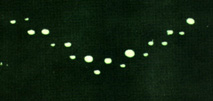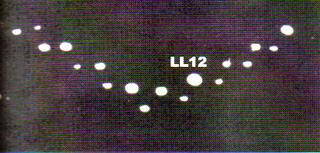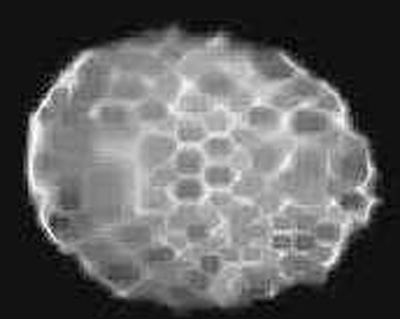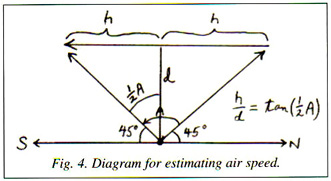New Findings on the Lubbock Lights
By Donald R. Burleson (Copyright 2001)
On the evening of August 25, 1951, a wing-like formation of at
least 18 bluish objects passed over Lubbock, Texas, crossing the night
sky in only a few seconds. Four professors from Texas Tech University
observed the objects and notified the editorial staff of the Lubbock
Avalanche-Journal, meeting at first with skepticism. The mysterious
objects reappeared later that night and on subsequent nights to the
professors and other witnesses.
Then, late on the evening of August 31 at about 11:30
p.m., Carl Hart Jr., a Texas Tech freshman, saw a V-formation of 18-20
white lights pass by his upstairs bedroom window. He got his 35mm Kodak
camera and rushed out into the backyard of his parents' home. The
lights passed over two more times in the next few minutes, and he took
five photos of the objects. In one of these photos there is very little
camera movement so the lights are captured with admirable clarity.
Four of the photos now exist, while the fifth was apparently lost early
on. Air Force investigators would later declare that the Lubbock
objects were birds, specifically ducks, reflecting street lights; still
later Donald Menzel claimed that the objects were reflections of street
lights on clouds. (I have several new Lubbock Lights witnesses—see
Chapter 7 of my The Golden Age of UFOs—one of whom saw the objects in
the country where there were no city lights; all my witnesses were
adamant on the point that the Lubbock objects were not birds of any
imaginable kind.)
In the field of UFO studies, the now famous Lubbock Lights sightings stand out as a remarkably well-attested case for at least two reasons: There were multiple witnesses (some of whom had graduate degrees and were critical observers), and there is photographic evidence in the form of the Carl Hart photos. It is still possible to learn a great deal from the witness accounts and the photos.
The four Texas Tech professors who first reported the
objects were well-accustomed to careful and detailed observation; their
respective fields of expertise were petroleum engineering (William Lyon
Ducker), chemical engineering (A. G. Oberg), physics (E. F. George),
and geology (W. I. Robinson). True to their scientific and engineering
training, when they saw the wing formation of bluish lights, they
faithfully recorded what amounts to an angular velocity of 30° of
arc per second by noting that the objects, passing overhead, moved from
45° above the north horizon
to 45° above the south horizon in roughly three seconds. This
observation
is nicely (and quite independently) corroborated by the Edward Ruppelt
interviews
with photographer Carl Hart Jr., who said that the objects traversed
120° of arc in about 4 seconds, for an angular velocity again of
30° per second. (However, it is true that the professors saw the
object on a different night than Hart did; see Edward J. Ruppelt, The
Report on Unidentified
Flying Objects, Ace Books, 1956, p. 136.)

Let us consider the series of Hart photos, one image of which is shown in Figure 1. (Standard high-quality scans of the Lubbock Lights photos can be downloaded from a number of reputable Web sites. I have used high-resolution scans that take well to "zooming in" without the image breakup characteristic of lesser-quality scans.)
After Air Force investigators interviewed the young photographer in Lubbock beginning in September 1951, the photo images were examined by analysts at the Air Technical Intelligence Center (ATIC) at Wright-Patterson Air Force Base in Ohio. ATIC's own findings are useful here. (For an account of the center's work, see Brad Steiger, ed., Project Blue Book: The Top Secret UFO Findings Revealed, Ballantine Books, 1976, pp. 99-100.) It determined that the image size (of the whole wing formation of 18 objects) was 0.12 inches across on the negative, and that from the camera's focal length of 2 inches, the ratio 0.12" / 2" yielded an angular size of 0.06 radians (roughly 3.4°) for the whole group of 18 objects in the sky (in comparison, the moon subtends 0.5°). ATIC further concluded, in effect, that for every mile (5,280 feet) that the lights were distant from the camera, the size of the wing would have been 0.06 x 5,280 = 316.8 feet. (ATIC actually said 310 ± 30 feet.)
This only establishes a relation between size and distance from the camera. For example, if the objects had been two miles from the camera, the wing would have been twice as far across, or about 630 feet. But we can do better than that, with some added information.

I have set up a numbering system for the 18 objects shown in Figure 1,
calling them LL01, LL02, etc., through LL18 from left to right in the
figure. And I have found it productive to concentrate on object LL12
for most of my computer image-enhancement work, as there are
micro-differences in sharpness of focus, with LL12 (Figure 2) being one
of the clearer object-images. Over a period of two years I have
gradually been able to bring the underbelly structure of LL12 into
view. (See Figure 3.) The remarkable discovery
here is that the underside is cellular, with hexagonal features like
the
cells of a beehive. Similar structures can be seen on the other objects
in the group, but it is clearest for LL12.
I have used a wide range of image-enhancement software, starting with
the old Microsoft PhotoEditor, exporting and importing images between
thai pro^r^D ofri others including Photo Finish, Adobe Photoshop,
Graphics Workshop, and MGI PhotoSuite, and finishing with die superb
state-of-the-art program Lucis, a product of Image Con tent Technology.
In any such undertaking, of coarse, one must be exceedingly cautious
not to alter an image in any fundamental way—for example, one should
not do anything to change the shape of the object in the image. The
best approach is to ease the image through very small and gradual
enhancements that clarify its detail.

Fig. 3. Object LL12, enlarged.
Basically, using the combinations of programs mentioned, with Lucis
performing the final operations. I have adjusted gamma, contrast, and
brightness, and have slowly sharpened and delineated the edges in the
image
of LL12, ultimately using the Lucis software's "double cursor"
algorithm to simultaneously detail-enhance and smooth the image until
the underside of LL12 was visible, with its beehive, hexagonal,
cellular structure.
The significant thing about this underbelly structure, for at least one of the objects seen and photographed over Lubbock, Texas, in August 1951, is that a Roswell crash debris witness has described the same structure on the underside of what may well be the crashed Roswell object of 1947. When I interviewed George Newling on May 12, 2001 (following up on an interview by Don Schmitt) and handed him a printout of the beehive LL12 image, without telling him how or where I had gotten it, he said, "This is what I saw in the bomb bay." He was a ground maintenance crew member in Roswell in 1947 and had glimpsed a large, metallic-gray object propped up or wedged in the bomb bay of a B-29; afterwards he was immediately escorted away from the plane by MPs with machine guns. From Newling's testimony, it would appear that the Lubbock objects and the Roswell UFO were quite similar.
Newling describes the peculiar object in Roswell as being tightly fitted into the B-29 bomb bay, and as that bomb bay is known to have been 9.5 feet across at its widest point, it follows that the object (assuming that what Newling saw was the whole object) was about 9.5 feet across. As a working hypothesis, I will assume for the moment, then, that each of the Lubbock Lights, if essentially the same kind of object, was about 9.5 feet across.
In an enlargement of the wing formation in Figure 2, one may note that the LL12 image is 1 /18 of the angular size of the whole formation, though not because there are 18 objects (this is a coincidence, as the objects have space between them and are not linearly arranged), for an LL12 angular size of (1/18) x 0.06 = 1/300 of a radian. Also, the distance across the wing would then be 18x9.5 =171 feet. Recall that ATIC' s analysis noted that the lights would span about 317 feet if one mile from the camera. If the lights actually spanned less than that distance, then they must have been closer to form the same image size on the negative. Since one may multiply angular size by distance d to obtain an approximation of the object's actual size, and since the size of LL12 would hypothetically seem to be about 9.5 feet, we have (1/300) x d = 9.5, or distance from camera is approximately d = 300 x 9.5 = 2,850 feet.
Then by doing a little further computation under the current assumptions, we may approximate the air speed. I've provided a diagram in Figure 4 to illustrate the calculations. If we let h denote half the distance flown in three seconds in the Texas Tech professors' sighting, and let A be the angle subtended from first sighting to loss from view (i.e., A = 90°), we have h/d=lan(A/2) = tan(45°) = 1, so that h = d = 2,850, and the whole distance flown in 3 seconds is about 2 x 2,850 = 5.700 feet, for an air speed of 5,700/3 = 1,900 feet per second or (1,900 ft/sec x 3,600 sec/hr) / 5,280 ft/mile, or approximately 1,300 miles per hour. This is nearly twice the top speed for conventional aircraft of that time.

Fig. 4. Diagram for estimating air speed.
The duck explanation for the Lubbock Lights appears to be in a bit of trouble at these speeds, unless the Lubbock ducks were shot out of a cannon.
An enlargement of the cellular-bottom enhancement of LL12 shows that the object itself is about 9 times as long as an individual hex cell, and for an LL12 length of 9.5 feet, this makes each beehive-cell about 1.06 feet across. It is certainly natural to wonder whether Carl Hart's camera (a Kodak 35, with a 2-inch or 50mm lens, using 1/10-second shutter speed with a f3.5 setting) had the power to resolve a surface feature of this size at the distance computed. In considering this question, I consulted with Bruce Maccabee, easily the highest authority in the field of optics as it relates to UFO studies. He indicated that the camera could be expected to resolve images of 20 microns or more at the film plane, which for the given lens depth would translate into an angular size of 0.00040 radians. This in turn translates into the camera's resolving an image one foot across at a distance of 2,500 feet. Maccabee said that if the surface feature (one hex cell) were much less than one foot across at that distance, there could be difficulties of resolution. As I have approximated the cell width as slightly more than one foot, at only a slightly greater distance than 2,500 feet, I conclude that while the image-resolution requirements of the current problem are at the edge of the camera's capability, the appearance of the hexagonal cellular structure under the circumstances described is reasonably consistent with the resolving power of the camera.
The important thing here is that the hexagonal cells have appeared after image manipulation and (as Maccabee noted) are well resolved. Even though my interview with George Newling strongly suggests that the Roswell object and the Lubbock objects were similar, perhaps even identical, in design, the logical possibility remains that the two objects still could be of different sizes. It is also possible that the object that Newling glimpsed was only part of the original craft. Thus it is conceivable that the individual Lubbock discs are (say) larger than 9.5 feet, in which case (the angular size at the film plane being fixed) the distance has to be greater than 2,850 feet; or that the distance is less than 2,850 feet, in which case the object size would be smaller.
In other words, there is a direct relationship between the distance and size of the formation (and object LL12) since we know the details of the camera used to take the photos. Although distance and size are both unknown (I am using Newling's testimony to estimate the size of LL12 and then to calculate the distance), one can entertain various other scenarios based on any arbitrary hypothetical disc size. For example, a disc 12 feet long would have hex cells 1.33 feet across, would be 3,600 feet from the camera, and would have an air speed (again based on witness accounts of angular speed) of about 1 ,640 miles per hour. Likewise, a disc 15 feet long would have hex cells 1.67 feet across, would be 4,500 feet from the camera, and would have air speed of 2,040 miles per hour, all proportional to assumed disc size.
In all these scenarios, however, the angular disc size and angular hex-cell size would be the same, being a function of image size and lens focal distance. That is, the size of the images on the negative is fixed. Thus the angular size of the wing formation is (according to ATIC) 0.06 radians, so that the angular size of LL12 would be (1/18) x 0.06 and the angular size of a cell would be (1/9) x (1/18) x 0.06 = 0.00037 radians, no matter the distance to LL1 2 or its physical size. The angular size of a cell is not significantly different from the necessary 0.00040 radians, so that whatever the actual disk size (and I suspect it is close to the 9.5 feet indicated by the Roswell bomb-bay width), the resolution of a cell remains just within the capability of the camera. It should be noted that we are working here with approximate figures, because the original angular speed observations, though consistent, must be regarded as approximate, as are the ATIC image size figures; after all, a "two inch" lens and a "50 mm" lens are generally regarded as the same, though two inches is in fact closer to 50.8 mm. Nevertheless, the cellular beehive structure is so well resolved in the enhancements that it is clearly a physically real feature not outside the range of possible optics.
Indeed the "beehive" is a remarkable UFO underbelly
feature, about whose purpose we can only speculate. Perhaps these cells
convert atmospheric gases, or even photons, directly into propulsive
energy. In any event, the case seems strong that the Lubbock Lights
were highly uncommon objects, and a defensible alternative to declaring
them extraterrestrial would be hard to find.
(Donald R. Burleson is a field
investigator and research consultant for the Mutual UFO Network. He
lives in Roswell, New Mexico, and is the director of one of the
computer labs at Eastern New Mexico University. His most recent book is
The Golden Age of UFOs.)
Source:
CUFOS IUR (International UFO
Reporter) Issue: Summer 2001, pages 3-5.
Be
sure and visit the CUFOS Web
Site: http://www.cufos.org/
NICAP Home Page